Finanční stabilita vs. finanční rizika ze změny klimatu - čnBlog
Do popředí zájmu dohledových orgánů (externí odkaz) včetně České národní banky se v posledních letech dostala finanční rizika vyplývající ze změn klimatu. Hlavním důvodem je možný dopad materializace těchto rizik na stabilitu a odolnost finančních institucí a potažmo celého finančního systému. Ze zkušeností posledních dekád víme, že finanční krize vznikají zejména v důsledku náhlých změn cen rizikových aktiv. Co to má společného s klimatickým rizikem? Náhlé změny cen aktiv by mohly nastat i v důsledku častějších přírodních katastrof, rozsáhlých technologických změn či vlivem regulatorních aktivit souvisejících s klimatem. V krátkodobém až střednědobém horizontu představují větší „hrozbu“ pro finanční stabilitu politická rozhodnutí reagující na změnu klimatu např. v podobě náhlého zavedení uhlíkové daně, které by mohlo způsobit rychlé přecenění široké škály aktiv. ČNB jako orgán dohledu nemá výslovný mandát reagovat svými dohledovými nástroji přímo na změny klimatu, ale vzhledem k rozsahu potenciálního dopadu těchto změn považuje za nutné v rámci svého stávajícího mandátu finanční rizika vyplývající ze změn klimatu monitorovat, pomáhat je předvídat, analyzovat, posuzovat, tím je i mírnit a zajistit vůči nim odolný finanční systém.
V zásadě se rozlišují dva hlavní typy klimatických rizik, jejichž materializace má dopad na hodnotu některých aktiv v držení finančních institucí či jejich klientů: fyzická a tranzitivní rizika (externí odkaz). Podstatou fyzických rizik je samotná změna klimatu a z ní vyplývající klimatické jevy (vlny veder, rozsáhlé požáry, povodně, růst průměrné teploty, změna v oceánských proudech, zvýšení hladiny moří aj.). V tomto případě hodnota aktiv klesá v přímém důsledku působení klimatických jevů, které mohou poškodit majetek, infrastrukturu, narušit proces výroby, omezit plynulost zahraničního obchodu a globálních dodavatelských řetězců či negativně ovlivnit zdraví obyvatelstva. Tranzitivní rizika souvisejí s rychlostí přechodu na nízkoemisní ekonomiku, neboť při tom dochází k významným strukturálním změnám, k potenciálnímu znehodnocení části kapitálové zásoby v důsledku emisních omezení, ke ztíženému financování „neekologických“ podniků, projektů apod. Zdrojem tranzitivních rizik mohou být vedle technologického pokroku zvyšující se dostupnost a rentabilita existujících zelených technologií zejména reakce vlád a změny chování firem, domácností či investorů na změnu klimatu. Pokles hodnoty tak bude do značné míry spojen s plněním mezinárodních environmentálních cílů a globální veřejnou iniciativou k ochraně klimatu.
Z výše uvedeného je zřejmé, že klimatická rizika mají potenciál se projevit materializací tradičních finančních rizik (viz tabulka Finanční rizika vyplývající ze změn klimatu), a to prostřednictvím mikro- či makroekonomického transmisního kanálu. Mikroekonomickými transmisními kanály se klimatická rizika promítají do bilancí finančních institucí nebo jejich protistran napřímo. Makroekonomickými transmisními kanály pak dopadají nepřímo skrze ovlivnění celkového ekonomického prostředí a makroekonomických veličin, jako jsou výše zadlužení, velikost výstupu ekonomiky či nezaměstnanost. Často uváděnými příklady nárůstu finančního rizika z klimatických změn jsou pokles hodnoty kapitálu či bohatství dlužníků snižující jejich bonitu a fyzické znehodnocení jejich majetku používaného jako zástavy, příliš vysoká cenová volatilita zastavovaného majetku, ztížené a zdražené financování projektů s negativními klimatickými dopady, nárůst nemocnosti, mortality a pokles produktivity práce dopadající na ekonomický výstup a v neposlední řadě na veřejné finance.
Tabulka – Finanční rizika vyplývající ze změn klimatu
| Typ finančního rizika | Možné promítnutí dopadů klimatických rizik |
| Úvěrové | Materializace klimatických rizik může snížit schopnost dlužníků splácet a obsluhovat dluh nebo zvýšit ztráty bank při selhání dlužníka vlivem nižší hodnoty zástavy. Dále může negativně ovlivnit i makroekonomický vývoj a vést k nižšímu výstupu ekonomiky, nárůstu mortality a poklesu produktivity práce. |
| Tržní | Projevy klimatických rizik mohou vést k vyšší volatilitě či trvalému snížení hodnot finančních aktiv. Může zároveň dojít ke snížení efektivity řízení rizik vlivem narušení dlouhodobých pozorovaných vztahů mezi cenami jednotlivých typů aktiv a ovlivnění tržní likvidity vybraných aktiv. |
| Likviditní | Změna tržních podmínek vyvolaná klimatickými riziky může omezit přístup bank ke zdrojům financování. Banky zároveň mohou být přechodně pod vyšším tlakem na výběr depozit a čerpání úvěrových linek. |
| Operační | Nárůst rizik spojených s dodržováním regulatorních nařízení spojených s „klimaticky citlivými“ aktivitami. |
| Reputační | Posun ve spotřebitelském sentimentu směrem k udržitelnému chování může negativně ovlivnit reputaci jednotlivých bank, u nichž mohou panovat obavy o udržitelný obchodní model. |
Zdroj: BCBS (externí odkaz)
Klimatická rizika se týkají i ČR
Materializace fyzických klimatických rizik má dlouhodobější charakter a potenciál slábnout při vyšších tranzitivních klimatických rizicích, a to v jednoduché logice: čím rychlejší a ráznější bude přechod na udržitelnou ekonomiku, tím nižší bude četnost extrémních klimatických jevů v budoucnosti. Projevení tranzitivních rizik v nárůstu finančních rizik se proto může týkat již střednědobého horizontu. Vyplývá to i z Pařížské dohody (externí odkaz), resp. z evropského právního rámce pro klima (externí odkaz) s cíli snížit emise skleníkových plynů do roku 2030 alespoň o 55 % (vůči roku 1990) a do roku 2050 dosáhnout klimatické neutrality EU. Při odhlédnutí od adaptačních programů souvisejících s touto ekonomickou transformací by tak měla tato politická rozhodnutí nejsilněji ovlivnit financování firem s vysokou relativní emisní intenzitou a na ně navazující subjekty.
V celoevropském srovnání má ČR mix podnikových odvětví s vysokým podílem emisí. Při srovnání relativní emisní intenzity (poměr celkových emisí produkovaných nefinančními podniky a jejich přidané hodnoty) vykazuje ČR výrazně vyšší hodnoty než země západní Evropy (Graf 1). V roce 2019 dosáhly emise skleníkových plynů v ČR okolo 122 mil. tun, což je při srovnání výše emisí na obyvatele s téměř 12 tunami třetí pozice v EU. Nejvyšší podíl na produkci emisí skleníkových plynů v ČR měla odvětví výrobců a distributorů energií. Pohledem přes poměr mezi tržbami a emisemi skleníkových plynů bylo toto odvětví následováno odvětvími nakládání s vodou a odpady, dopravou a zemědělstvím (Graf 2). U těchto odvětví lze očekávat největší změny související se „zelenou regulací“. Z hlediska síly vazby na domácí bankovní sektor byly těmto odvětvím ke konci roku 2019 poskytnuty úvěry ve výši přibližně 13 % celkového stavu úvěrů poskytnutých podnikovému sektoru (Zpráva o finanční stabilitě 2020/2021, Box 4).
Graf 1 – Emise v sektoru nefinančních podniků v evropském srovnání
(v %; pravá osa: v tunách ekvivalentu CO2 na milion EUR hrubé přidané hodnoty)
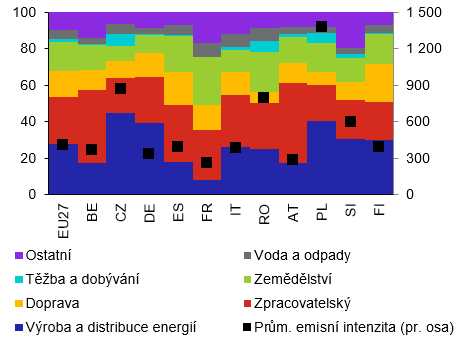
Zdroj: Eurostat
Poznámka: Průměrná emisní intenzita je poměr emisí skleníkových plynů produkovaných sektorem nefinančních podniků a jejich hrubou přidanou hodnotu
Graf 2 – Přímá a nepřímá emisní náročnost vybraných odvětví nefinančních podniků v ČR v roce 2019
(v tunách ekvivalentu CO2 na milion Kč tržeb)
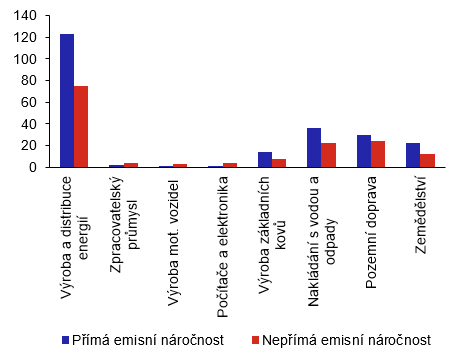
Zdroj: Eurostat, ČSÚ
Hodnocení finančních rizik ze změny klimatu naráží na potíže s nedostatkem dat a metod měření
Výše dluhu potenciálně zasažených odvětví je pouze jedním a navíc velmi hrubým ukazatelem pro hodnocení finančních rizik ze změny klimatu, neboť zasaženy budou zcela jistě i navazující domácí či zahraniční subjekty v celém řetězci výroby včetně spotřebitelů, potenciálně také v roli dlužníků či investorů. Rizika související s klimatem mohou být navíc přenášena nebo zesilována uvnitř finančního sektoru, což pramení ze vzájemné závislosti mezi institucemi jako např. bankami a pojišťovnami. Odhad poklesu hodnoty portfolia uvízlých aktiv v bilancích institucí způsobeného klimatickou změnou proto vyžaduje rozsáhlou novou datovou základu, kdy jsou na úrovni vykazujících nejen nefinanční podniky, ale všichni účastníci finančního trhu dotčení klimatickými riziky včetně domácností.
Další neméně náročný úkol je výběr vhodných finančních ukazatelů, metod a modelů potřebných ke kvantifikaci finančních rizik vzniklých z klimatických změn. Z povahy klimatických rizik je zřejmá jejich nepředvídatelnost, nelineárnost jejich dopadů a materializace ve vzdáleném časovém horizontu. Profesionální správci aktiv zpravidla věnují už poměrně malou pozornost rozložení možných překvapení v horizontu 10 let, natož těm, která se mohou objevit za 50 let. Sebekvalitnější data o vývoji faktorů klimatického rizika nemusí být vždy relevantní, jelikož minulé vzorce vývoje klimatických proměnných nejsou platné pro budoucnost. Také dopady materializace tranzitivních klimatických rizik jsou zcela novou oblastí a lze se pouze dohadovat nad jejich rozsahem. Tradiční modely k oceňování finančních rizik závislých na historických datech tak nejsou vhodnou volbou a jako vhodnější nástroj se nabízejí citlivostní analýzy či zátěžové testy.
Zátěžové testování jako nadějná metoda
Zátěžové testy pro vyhodnocení dopadu nepříznivého scénáře do bilancí finančních institucí se v současné praxi nejčastěji provádí na horizontu jednoho až tří, výjimečně pěti let, a to z důvodu relativně krátké průměrné splatnosti většiny položek v bilancích. Horizont klimatického scénáře se však pohybuje od 30 do 50 let. Prodlužování délky horizontu scénáře přirozeně vede k nárůstu nejistoty. Dlouhý časový horizont vyžaduje dynamickou analýzu bilancí finančních institucí. I přes uvedená úskalí je žádoucí modelovat vývoj obou klimatických rizik – fyzického i tranzitivního. Zachycení makroekonomických důsledků ekologického přechodu na takto dlouhém horizontu bude přitom do značné míry záviset na tom, jak bude tento přechod řízen v praxi. Nejen z těchto důvodů je vhodnější vytvářet a testovat relativně vysoký počet klimatických scénářů. Tyto scénáře se promítnou do vývoje jednotlivých sektorů reálné ekonomiky podle jejich citlivosti na projevy klimatických rizik pomocí mezinárodní sektorové klasifikace (externí odkaz) či taxonomie (externí odkaz). Jinými slovy pro mapování klimatických rizik a aktiv finančních institucí je nutné disponovat technickou znalostí emisní náročnosti jednotlivých aktiv. Následně je možné provést kvantifikaci dopadu změn vývoje v reálné ekonomice na finanční sektor.
Ačkoli v současné době existují značné limity pro měření potenciálních ztrát finančního sektoru z klimatických rizik, je rozhodně žádoucí mít pro podporu účinného řízení rizik a odolnost finančního systému alespoň pilotní klimatické zátěžové testy a ty dále rozvíjet. Zejména metodické a datové potíže vyžadují větší úsilí i v oblasti výzkumu. Řada centrálních bank či orgánů dohledu již k zátěžovému testování klimatických rizik přistoupila nebo tyto testy rozvíjí (např. Austrálie (externí odkaz), Dánsko (externí odkaz), Francie (externí odkaz), Kanada (externí odkaz), Nizozemí (externí odkaz), Velká Británie (externí odkaz), USA (externí odkaz)). Rozvoj obdobných testů probíhá rovněž v ČNB.
Finanční rizika ze změny klimatu jsou globální záležitostí
K výzvě zahrnout klimatická rizika do zátěžových testů finančních institucí se připojily také mezinárodní organizace, včetně Banky pro mezinárodní platby (externí odkaz), Mezinárodního měnového fondu (externí odkaz), Rady pro finanční stabilitu (externí odkaz) či Sítě pro ekologizaci finančního systému (externí odkaz). Poslední jmenovaná organizace také vydala klimatické scénáře vhodné pro potřeby orgánů dohledu. Tyto scénáře zahrnují v různých nuancích předpoklady o klimatické politice a regulaci, vývoji technologií, sentimentu spotřebitelů a rovněž rizikové averzi investorů vůči klimatickým rizikům. Tato organizace, a také např. pracovní skupina pod Radou pro finanční stabilitu (FSB (externí odkaz)), se z globálního pohledu intenzivně věnují otázce harmonizace a zveřejňování potřebných informací o rizicích souvisejících s klimatem, které by využívaly orgány dohledu, centrální banky, ale i investoři, věřitelé či pojišťovny (FSB (externí odkaz), NGFS (externí odkaz)). Rizika pro finanční stabilitu vznikající ze změny klimatu mapuje také zpráva (externí odkaz) z pera projektového týmu zřízeného ve spolupráci Evropské centrální banky a Evropské rady pro systémová rizika. Zpráva přispívá rozvojem analytické základny pro cílenější a účinnější politická opatření, neboť výsledky pilotních klimatických zátěžových testů zatím nemohou být využívány pro nastavování obezřetnostních nástrojů. Analytickou a výzkumnou práci v oblasti finančních rizik souvisejících se změnou klimatu zahájila rovněž pracovní skupina zřízená Basilejským výborem pro bankovní dohled (BCBSa (externí odkaz), BCBSb (externí odkaz)). Ta se rovněž bude zabývat hodnocením, do jaké míry jsou finanční rizika související s klimatem začleněna do stávajícího basilejského rámce, a určením účinných postupů dohledu pro zmírnění těchto rizik.
Globální přesah finančních rizik souvisejících s klimatickými riziky nevylučuje, nýbrž naznačuje nezbytnost řešit tato rizika také na národní úrovni. Ekologizace české ekonomiky vyžaduje připravenost jejích jednotlivých článků včetně finančních institucí na dopady zaváděných regulací. Nejen z těchto důvodů se představitelé či experti ČNB účastní mezinárodních diskusí o změnách finanční regulace související s klimatickými riziky.
Basel Committee
on Banking Supervision

Climate-related financial risks:
a survey on current initiatives
April 2020

This publication is available on the BIS website (www.bis.org).
© Bank for International Settlements 2020. All rights reserved. Brief excerpts may be reproduced or translated provided the source is stated.
ISBN 978-92-9259-375-9 (online)
Contents
iii
Introduction
Climate-related financial risks refer to the set of potential risks that may result from climate change and that could potentially impact the safety and soundness of individual financial institutions and have broader financial stability implications for the banking system. These risks are typically classified as physical and transition risks. Physical impacts include the potential economic costs and financial losses resulting from the increasing severity and frequency of extreme climate-change related events, and longer-term progressive shifts in the cliate. Transition impacts relate to the process of adjusting to a low-carbon economy.
The Basel Committee on Banking Supervision recently established a high-level Task Force on Climate-related Financial Risks (TFCR). The TFCR is charged with contributing to the Committee’s mandate of enhancing global financial stability by undertaking the following initial initiatives on climate-related financial risks:
• a stocktake of members’ existing regulatory and supervisory initiatives on climate-related financial risks;
• a set of analytical reports on climate-related financial risks, including a literature review, and reports on the transmission channels of such risks to the banking system as well as on measurement methodologies; and
• the development of effective supervisory practices in order to mitigate climate-related financial
risks.
This report summarises the main results of the stocktake of members’ initiatives on climaterelated financial risks. In short, the survey suggests that:
• the majority of Basel Committee members consider it appropriate to address climate-related financial risks within their existing regulatory and supervisory frameworks;
• an overwhelmingly large share of members have conducted research related to the measurement of climate-related financial risks, while a number of members identified operational challenges in assessing climate-related financial risks such as data availability, methodological challenges, and difficulties in mapping of transmission channels. A majority of the members have raised risk awareness with banks through different channels, and many banks are disclosing information related to climate-related financial risks to some extent; and
• approximately two-fifths of members have issued, or are in process of issuing, more principlesbased guidance regarding climate-related financial risks. However, the majority of members have not factored, or have not yet considered factoring, the mitigation of such risks into the prudential capital framework.
Responses to the stocktake
In total, responses to the stocktake were received from 27 members and observers, including the European Central Bank (ECB) and the European Banking Authority (EBA, See Figure 1 for the geographical range of the responses). The full list of members and observers that participated in the stocktake is set out in Annex 1.[1]
Figure 1: Respondents to the stocktake (a)

Sources: Basel Committee calculations and mapchart.net
(a) The ECB and the EBA also responded to the stocktake; the map includes BCBS jurisdictions from the European Union that responded to the stocktake.
Questionnaire
The stocktake sought responses from Basel Committee members on the following areas (see Annex 2 for the full set of questions):
• the role of climate-related financial risks in the regulatory and supervisory framework;
• research related to the measurement of climate-related financial risks;
• measures to raise awareness of climate-related financial risks among stakeholders;
• banks’ approaches to managing and disclosing climate-related financial risks; • the supervisory treatment of climate-related financial risks; and
• other initiatives that are underway among respondents.
The stocktake was conducted before the coronavirus disease pandemic, and the responses
provided by members is correct as of February 2020.
Results
This section summarises the main results of the stocktake themes outlined above. Since not all members responded to all questions, the number of respondents set out in the summary charts below vary by theme.
The role of climate-related financial risks in the regulatory and supervisory framework
The stocktake asked members whether climate-related financial risks are specifically designated in their regulatory and supervisory framework, and whether the mandate of their institution explicitly covers climate-related financial risks.
A large majority of respondents noted that they do not have an explicit mandate with regards to climate-related financial risks but indicated that such risks could potentially impact the safety and soundness of individual financial institutions and could pose potential financial stability concerns for the financial system. Accordingly, these respondents view it as appropriate to act within their existing mandate to mitigate climate-related financial risks. One respondent has a specifically designated mandate with regards to environmental, social and governance (ESG) risks, which include climate-related financial risks.
Most respondents considered climate-related financial risks to fall implicitly within their existing regulatory and supervisory framework, since the existing prudential framework requests banks to manage all risks of relevance, including climate-related financial risks. A few respondents were of the view that climate-related financial risks should, to the largest extent possible, be manifested or embedded into the existing risk categories (eg credit risk, operation risk, etc.), rather than be considered a new category of risk.
Research related to measurement of climate-related financial risks
| All respondents noted that climate change may result in risks that could potentially have financial stability implications for the banking system. In total, 24 of the |
Chart 1: Number of respondents who have conducted research on climate-related financial risks |
| might be vulnerable to climate change; and | ||
|
• |
scenario analysis and stress testing on climate- related financial risks. |
Source: Basel Committee. |
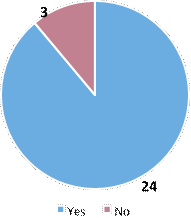 respondents reported that they have conducted research related to the
measurement of financial risks related to climate change (Chart 1).
respondents reported that they have conducted research related to the
measurement of financial risks related to climate change (Chart 1).
Respondents currently adopt varying approaches to assess climate-related financial risks. The most commonly used approaches include:
• qualitative studies on the transmission channels
from climate change to financial risks and financial stability;
• quantitative estimation of the exposures of the financial sector to sectors or geographies that
In addition, a few respondents use scorecards or heat maps to assess the materiality of specific physical or transition risks, and two jurisdictions reported that they are constructing key risk indicators to monitor risks related to climate change.
While no respondents reported specific barriers from a legal or enforcement perspective that prevent them from considering climate-related financial risks, 15 respondents identified operational challenges in developing a robust framework to assess climate-related financial risks (Chart 2). The most commonly cited challenges comprise the following:
• data availability: ten out of the 15 respondents highlighted the importance of bridging data gaps. They indicated that current data are not sufficiently granular or reliable to feed into the potential assessment models. Consistent emissions/climate-related data are needed across jurisdictions and across sectors to undertake further comparable risk analysis.
• methodological challenges: another key challenge identified by respondents is the lack of a harmonised and robust analytical framework for assessing climate-related financial risks. Several respondents highlighted the inherent uncertainties in quantifying the impact of climate change, which could be accentuated or mitigated depending on the speed and nature of innovations, political actions and environmental effects. Given the complexity involved in evaluations, the assessment techniques regarding climate-change financial risks are evolving and tend to be jurisdiction-specific. In addition, respondents were of the view that the assessment of climaterelated financial risks should adopt a forward-looking approach, which further increases the difficulty of any risk assessment.
• difficulties in mapping of transmission channels: a handful of respondents mentioned the insufficient understanding in how climate change and the transition towards a low-carbon economy affect specific sectors, regions, markets and consequently the financial system. Broadly, the research on transmission channels between climate change and financial sectors is still nascent, and it is difficult to pinpoint how the risks could materialise.
Jurisdictions also mentioned other challenges, such as:
• a lack of capacity and human resources to identify and mitigate the risks appropriately;
• time horizon misalignments between the ‘typical’ horizon of banks’ and supervisors’ risk analyses and the longer-term climate forecast horizon;
• a lack of sufficiently granular and plausible
forecasts related to climate change;
• varying degrees of awareness among jurisdictions and banks to address climate-related financial risks;
• a lack of a rigorous credit rating regime related to climate-related financial risks;
• the lack of internationally-coordinated actions on the management of climate-related financial risks; and
• a lack of a clear and widely accepted taxonomy regarding “green” and “brown” assets.
Chart 2: Challenges identified by number of jurisdictions
Data availability
Methogological challenges
Risk transmission channels
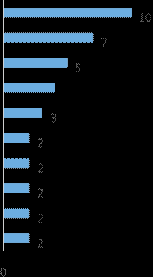 Capacity/resources 4
Capacity/resources 4
Time horizon misalignment
Climate-related forecasts
Degree of awareness Credit rating regime
International coordination
Taxonomy
2 4 6 8 10 12
Source: Basel Committee.
Measures to raise awareness of climate-related financial risks among stakeholders
A majority of respondents have raised climate-related financial risks with banks through public channels. Only two jurisdictions responded that they have not raised climate-related financial risks with banks (Chart 3).
The most frequently used channels for public communications with banks on climate-related risks are conferences and meetings, and speeches (Chart 4). However, respondents also make use of a number of other channels as well.[2]
|
Chart 3: Number of jurisdictions that have raised climate change financial risks with banks(a) |
Chart 4: Most frequently used public channels among jurisdictions(a) 25 |
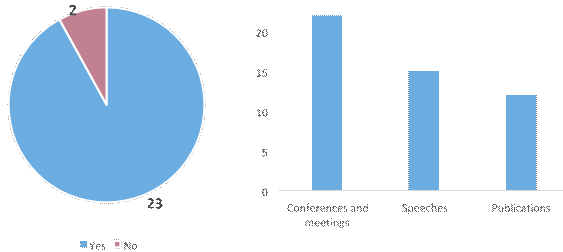
|
Source: Basel Committee. (a) For jurisdictions that answered relevant question in stocktake. |
Source: Basel Committee. (a) For jurisdictions that answered relevant question in stocktake. |
Banks’ approaches to managing and disclosing climate-related financial risks
The stocktake asked respondents to provide information regarding the ways in which they survey banks’ risk management of climate-related financial risks, and the disclosure by banks of such risks.
18 jurisdictions indicated that they have surveyed banks on climate-related financial risks at least once, while 6 jurisdictions mentioned that they have not (Chart 5).
Among the jurisdictions that have surveyed banks, approximately half of them noted that banks’ approaches to the management of climate-related financial risks are at an early stage of development, and are therefore limited and evolving, with ample room for improvements. By and large, respondents noted that bigger banks are relatively more advanced in managing such risks compared to smaller banks. This is also the case with regards to banks’ internal governance (eg the engagement of the board of directors and the involvement of senior management). Only a few of the jurisdictions mentioned that some of their banks perform stress testing of climate-related financial risks as part of their risk management process. In most of these cases, respondents noted that banks’ models for stress testing are not sufficiently mature and are often hampered by a lack of relevant data.
In addition, respondents were asked if banks
Chart 5: Number of jurisdictions that have surveyed banks on climate-related financial
risks(a)
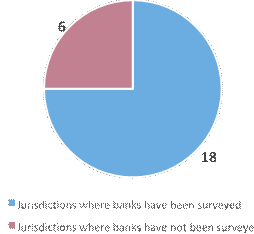
Source: Basel Committee.
(a) For jurisdictions that answered relevant question in stocktake.
in their jurisdictions disclose or discuss climate-related financial risks publicly. 20 jurisdictions reported that their banks disclose such information to varying degrees, while 3 jurisdictions indicated that banks do not disclose such information (Chart 6).
| Respondents highlighted a number of | |
| factors behind banks’ climate-related financial risk disclosures. For example, banks may disclose such information in response to national legislations or on a voluntary basis as a part of their risk management |
Chart 6: Number of jurisdictions in which banks disclose climate-related financial risks(a) |
 process. A majority of respondents reported that these disclosures
are currently made by banks on a voluntary basis, although some jurisdictions
noted that they have implemented some relevant disclosure requirements in their
national legislation. Almost half of the jurisdictions reported that banks’
disclosure in this area is to a large extent based on the recommendations and
framework for disclosure of climate-related financial risks published by the
Task Force on Climate-related Financial Disclosures (TCFD), although the exact
forms of disclosure seem
process. A majority of respondents reported that these disclosures
are currently made by banks on a voluntary basis, although some jurisdictions
noted that they have implemented some relevant disclosure requirements in their
national legislation. Almost half of the jurisdictions reported that banks’
disclosure in this area is to a large extent based on the recommendations and
framework for disclosure of climate-related financial risks published by the
Task Force on Climate-related Financial Disclosures (TCFD), although the exact
forms of disclosure seem
![]() to vary across banks. In some jurisdictions, the Jurisdictions where banks disclose to some extent recommendations
of the TCFD have been Jurisdictions where banks do not disclose
to vary across banks. In some jurisdictions, the Jurisdictions where banks disclose to some extent recommendations
of the TCFD have been Jurisdictions where banks do not disclose
| supplemented with non-binding guidelines. No | |
| jurisdictions reported that they provide a taxonomy to be used for disclosure by banks. Several European |
Source: Basel Committee. (a) For jurisdictions that answered relevant question in stocktake. |
respondents noted that regulation related to banks’ disclosures of climate-related financial risks is planned to come into force in 2022.
Supervisory treatment of climate-related financial risks
| The stocktake asked respondents whether they have issued dedicated supervisory guidance related to the governance, strategy and/or risk management of climate-related financial risks by banks. In total, |
Chart 7: Number of respondents who have issued supervisory guidance |
| and activities related to climate change risks; | ||
|
• |
encouraging financial institutions to take |
Source: Basel Committee. |
 approximately two-fifths of respondents reported that they have
issued, or are in process of issuing, such guidance. Supervisory guidance is
issued in the form of guidelines, action plans and supervisory statements, and
they are not always legally binding rules, rather principle-based or
interpretations of existing rules. From the guidance that has been issued or is
in process of being developed, the following supervisory expectations can be
observed:
approximately two-fifths of respondents reported that they have
issued, or are in process of issuing, such guidance. Supervisory guidance is
issued in the form of guidelines, action plans and supervisory statements, and
they are not always legally binding rules, rather principle-based or
interpretations of existing rules. From the guidance that has been issued or is
in process of being developed, the following supervisory expectations can be
observed:
• outlining supervisory plans on deliverables
actions in governance, risk management and disclosure of climate-related exposures and financial risks;
• providing guidance on how to properly integrate climate-related financial risks within risk management; and
• requiring banks to increase credit availability to ‘green’ and ‘low carbon’ sectors.
In addition to supervisory guidance, a few jurisdictions indicated that they are working on
identifying ‘best practices’ to mitigate climate-related financial risks. Some of these initiatives are being conducted together with private-sector participants.
The majority of respondents have not yet factored, or considered factoring, the mitigation of climate-related financial risks into the prudential capital framework. Some jurisdictions indicated that authorities are still quite far from being able to quantitatively assess the climate-related financial risks in the context of capital. As such, they have no short-term plans to consider applying Pillar 1 or Pillar 2 requirements for climate-related financial risks. One jurisdiction mentioned that it may include these risks in its existing framework to the extent that these risks pose an impact to financial stability.
In terms of setting Pillar 1 capital requirement, only one respondent noted that it is required to evaluate by 2025, whether a dedicated prudential treatment of exposures related to assets or activities associated substantially with environmental and/or social objectives would be justified with aim to incorporate such approach into the prudential regulation of banks.
With regard to the potential application of Pillar 2 capital add-ons, several jurisdictions are of the
view that the current Pillar 2 framework offers flexibility to address climate-related financial risks. Under Pillar 2, banks are required to develop the internal capital adequacy assessment process to capture all material risks that are not sufficiently covered under Pillar 1, and such risks would also include climaterelated financial risks, if they are assessed to be material to the individual financial institution.
Four jurisdictions emphasised that prudential regulations must not be adjusted in order to accommodate other non-prudential objectives. For example, lowering capital requirements by introducing a “green” supporting factor in an effort to boost sustainable finance is inappropriate in the absence of empirical evidence showing that that “green” exposures carry lower financial risks than “non-green” ones.
In addition to capital requirements, two jurisdictions reported that they are considering the introduction of an explicit mandatory requirement for financial institutions to disclose information on material climate-related financial exposures and risks, if voluntary disclosure is not producing convincing results. European respondents reported that for large banks subject to their supervision, mandatory disclosure on ESG risks would come into effect in 2022 and become part of Pillar 3 requirements. One respondent mentioned that it has incorporated climate-related financial risks into its macroprudential framework by conducting an assessment of the banks’ performance in providing credit to green sectors.
Other initiatives on climate-related financial risks and future work
Regarding other initiatives on climate-related financial risks pursued by members and observers, 17 jurisdictions indicated that they are pursuing additional work, which can be broadly divided into four different strands.
First, by and large one-third of the jurisdictions mentioned that participating in the work of the Network for Greening the Financial System (NGFS) continues to be a priority.
Second, roughly a third of the jurisdictions mentioned stress testing of climate-related financial risks as future potential work. In this context, stress testing has to be understood in a wide sense and includes developing key risk indicators and conducting sensitivity analysis.
Third, one jurisdiction stated that it is working to expand its sources of data available to researchers and to further collaborate with researchers and central banks in other jurisdictions.
Finally, a handful jurisdictions mentioned implementation and expansion of sustainable finance
as a potential future work in their jurisdictions.
Annex 1: List of participating Basel Committee members and observers(a)
|
Jurisdiction |
Institution |
| Argentina | Central Bank of Argentina |
| Australia | Australian Prudential Regulation Authority |
| Belgium | National Bank of Belgium |
| Brazil | Central Bank of Brazil |
| Canada | Office of the Superintendent of Financial Institutions |
| China |
People’s Bank of China China Banking and Insurance Regulatory Commission |
European Banking Authority
| European Central Bank | |
| France |
Banque de France Autorité de Contrôle Prudentiel et de Résolution |
| Germany |
BaFin |
| Hong Kong | Hong Kong Monetary Authority |
| Indonesia |
Bank Indonesia Otoritas Jasa Keuangan |
| Italy | Bank of Italy |
| Japan |
Financial Services Agency |
| Korea |
Bank of Korea Financial Supervisory Service |
| Malaysia | Bank Negara Malaysia |
| Mexico |
Banco de México National Banking and Securities Commission |
| Netherlands | De Nederlandsche Bank |
| Russia | Bank of Russia |
| Saudi Arabia | Saudi Arabian Monetary Authority |
| Singapore | Monetary Authority of Singapore |
| Spain | Banco de Espana |
| Sweden |
Sveriges Riksbank Finansinspektionen |
| Switzerland |
Swiss National Bank Swiss Financial Market Supervisory Authority |
| United Arab Emirates |
Dubai Financial Services Authority(b) |
| United Kingdom |
Prudential Regulation Authority |
| United States |
Federal Reserve Board Federal Reserve Bank of New York Federal Deposit Insurance Corporation Office of the Comptroller of the Currency |
Source: BCBS stocktake
(a) In some of the jurisdictions, responses were provided from several different national authorities. In the analysis of the results of the stocktake in this note, these answers have been merged.
(b) In the capacity as Co-Chair of the Basel Consultative Group.
![]()
Annex 2: Stocktake questionnaire
The stocktake on members’ regulatory and supervisory initiatives was comprised by eight questions related to the following themes:
• Question 1: the role of climate-related risks in the regulatory and supervisory framework;
Are climate-related risks specifically designated in your regulatory and supervisory framework? Are they implicitly covered? If so, please describe the way in which such risks are reflected in your framework, giving citations where possible, and whether the mandate of your institution explicitly cover such risks. Are there specific challenges or barriers that prevent you from considering climate-related risks?
• Question 2: the measures taken to raise awareness of climate-related risks;
Has your institution raised climate-related risks in discussions with banks and/or through public channels? If so, please describe the issues raised and the channels used.
• Question 3: research related to the measurement of climate-related risks;
Has your institution conducted any research related to the measurement of financial risks related to climate change, including analytical tools and models to assess physical and transitional risks related to climate change at a micro- and macro-level? If so, please describe the research conducted (including the data sources used and analytical approaches) and a link to the work, if published.
• Question 4: banks’ views on the impact of climate-related risks and their approaches to managing such risks;
Have you surveyed banks on: (i) their views on the financial impact of climate-related risks; and (ii) how they manage such risks? If yes, please describe the main takeaways from this work, including: (i) the role of the board of directors in discussing climate-related risks; and (ii) the data and methodologies used by banks in modelling the impact of climate-related financial risks.
• Question 5: supervisory guidance / expectations related to banks’ management of climate-
related risks;
Has your institution issued supervisory guidance related to the expected governance, strategy and/or risk management of climate-related risks by banks? If so, please describe the main elements of this guidance.
• Question 6: banks’ disclosure of climate-related risk information;
Do banks in your jurisdiction disclose or discuss climate-related financial risks (eg governance, strategy, risk management and/or metrics and targets)? If so, please describe the main elements of these disclosures. Are these disclosures voluntary or a result of supervisory expectations / requirements? Does your institution provide a taxonomy to be used for these disclosures?
• Question 7: current or planned consideration of climate-risk related initiatives with respect to the prudential framework;
Has your institution factored, or considered factoring, the mitigation of climate-related risks into its prudential framework? If so, please describe how you have factored this mitigation.
• Question 8: other initiatives underway related to climate-related risks.
What other initiatives are underway in your institution on climate-related risks?
Poslední zprávy z rubriky Makroekonomika:
Přečtěte si také:
Prezentace
18.04.2024 Daňové přiznání lidem provětralo peněženky....
15.04.2024 Kam půjdou úrokové sazby? Aktuální přehled...
15.04.2024 Zabouchnuté dveře vyřeší zámečník od pojišťovny...
Okénko investora

Mgr. Timur Barotov, BHS

Petr Lajsek, Purple Trading

Miroslav Novák, AKCENTA
Spotřebitelská inflace v eurozóně odeznívá, pro služby to však úplně neplatí

Olívia Lacenová, Wonderinterest Trading Ltd.

Michal Brothánek, AVANT IS

Jiří Cimpel, Cimpel & Partneři

Ali Daylami, BITmarkets
Bitcoin stanovil nové historické maximum – Je už na nákup pozdě?

Jakub Petruška, Zlaťáky.cz

_w60h45_w76h50.png)


